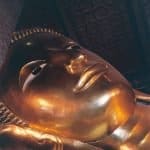More people needed to take the boat on the Irrawaddy river

Today I am taking a boat to Mingun, an archeological place of interest that is located 11km from Mandalay up the Irrawaddy river. The boat trip almost does not take place. I register as the first tourist at the jetty where I hear that at least three people have to arrive. Otherwise, the boat will not leave. The visit to Mingun is an initiative organized by the government; you pay for the boat trip, and also, you pay another fee of a couple of dollars for the maintenance and restoration of the site.

Guided around in Mingun by students

Two `students` show me around, even though I did not ask for it; one knows to provide the necessary historical details. In Mingun you will find the second largest bell in the world; a colossus weighing 90 tons, quite impressive to see. The Mingun Bell is located at the Pahtodawgyi temple, an uncompleted stupa that was supposed to reach 150 meters in height. Due to an earthquake in 1839, the stupa shows some huge cracks. A bit further from the great stupa is The Hsinbyume pagoda or the Myatheindan. This a beautiful archeological temple, built in 1816, completely white, and inspired after the mythical Mount Meru.

My first Burmese supper

Shortly after midday, our boat returns us along the Irrawaddy River to Mandalay. After a short siesta, I walk to the Eindawya pagoda; the most exciting part to see there is an original Buddha statue of 100 years old. But the attraction of the day seems to be me. In the evening I eat in a local restaurant. I am the only customer present; several surrounding servants observe me from A to Z during the tasting of my first pure Burmese supper. I can laugh at it myself.
Power cuts occur frequently in Myanmar
When I try to check my email later in the evening this is a disappointing experience. Frequent power cuts are the reason. Electricity power is out five times in the city today. Myanmar and modern times, it doesn’t really seem to go together well.
Discovery along the shore of the Irrawaddy

The next morning, spending my last day in Mandalay, I decide to wander around in the streets along the shore of the Irrawaddy River. By accident, near a local market, I discover an open-air workspace where they make Buddha sculptures. Handmade skills are still largely present around here, a craftmanship that has somewhat disappeared over the years in Europe.
Buddhist myths in a teak wood monastery
Later on, I visit the Golden Palace Monastery, the Shwenandaw Kyaung, near the city moat. This is a place for meditation entirely built from teak wood, with many carvings depicting Buddhist myths. At the time, the monastery was covered in gold-plates and was initially located at Amarapura, but it got dismantled and moved to Mandalay in 1878.

A Buddha covered in gold leaf
Then I head to the Southwest of town to the primary pilgrimage site of Mandalay, the Mahamuni Pagoda. This temple contains a famous Buddha image covered in layers of gold leaf by its worshippers. The Burmese believe the Mahamuni Buddha statue is a representation of the real Buddha, that is why they only allow men to come close to the image. Adjacent to the temple there is a small museum containing historical artifacts.

Time to move on
As it is still too early in the evening to retreat to my room, I go drink a beer at one of the rare open-air bars in the city, but I’m the only guest there, so I don`t stay too long. Spending the evenings on my own forms the most bothersome part of my trip here in Myanmar. It is time to move on to what should become the highlight of my journey, Bagan.







